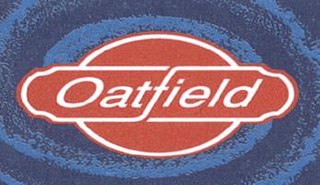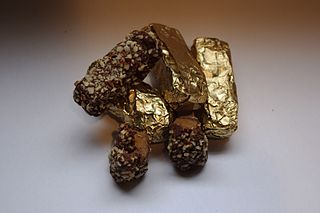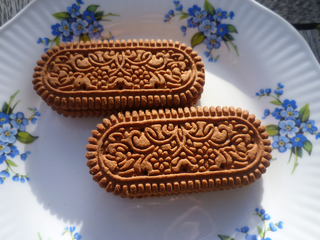Related Research Articles

Nutella is a brand of brown, sweetened hazelnut cocoa spread. Nutella is manufactured by the Italian company Ferrero and was introduced in 1964, although its first iteration dates to 1963.

Ferrero Rocher is a chocolate and hazelnut confectionery produced by the Italian company Ferrero. Michele Ferrero is credited as the product's creator.

Kit Kat is a chocolate-covered wafer bar confection created by Rowntree's of York, England. It is produced globally by Nestlé, except in the United States, where it is made under licence by the H. B. Reese Candy Company, a division of the Hershey Company.
White Knight is a brand of chocolate-coated, chewy, mint-flavoured confectionery bar sold in Australia. Originally produced by Hoadley's Chocolates it was later manufactured by Nestlé Australia. The packaging is blue and white and features a picture of a knight on a horse. Its slogan is 'Mighty Mint Chew'. The product was discontinued in 2016.

Tupla is a Finnish chocolate bar made by Cloetta. It consists of milk chocolate with a nougat-flavoured filling, coated with bits of almond.

Maltesers are a British confectionery product manufactured by Mars, Incorporated. First sold in the UK in 1937, they were originally aimed at women. They have since been sold in Europe, Australia, New Zealand, Canada, United States and Middle East. The slogan is "The lighter way to enjoy chocolate".

The Idaho Spud is a candy bar made by the Idaho Candy Company. It has continuously been in production since 1918 and is distributed primarily throughout the Pacific Northwest region of the United States. The wrapper of the product bears the slogan "The Candy Bar That Makes Idaho Famous". The bar was invented by Thomas "T.O." Smith, who founded the Idaho Candy Company in 1901. The potato- shaped bar consists of a chocolate and coconut flakes covered cocoa-flavored marshmallow center.

Fry's Chocolate Cream is a chocolate bar developed by J. S. Fry & Sons and currently manufactured by Cadbury. Launched in 1866—nineteen years after Fry's created the first moulded, solid chocolate eating bar — Fry's Chocolate Cream is the first mass-produced chocolate bar and is the world's oldest chocolate bar brand.

Chocolate is a food product made from roasted and ground cocoa pods mixed with fat and powdered sugar to produce a solid confectionery. There are several types of chocolate, classified primarily according to the proportion of cocoa and fat content used in a particular formulation.

Breakaway was a brand of chocolate-covered digestive biscuit from Nestlé, which started production in 1970 in the United Kingdom, manufactured by Rowntree Mackintosh Confectionery. Nestlé acquired the brand in 1988. It was discontinued in February 2024 after 54 years due to falling sales.

Oatfield was a chocolate and confectionery manufacturer located in Letterkenny, County Donegal, Ireland. The company was the oldest confectionery manufacturer in Ireland.
The U-NO Bar is a truffle type bar with almond bits covered in a thin layer of chocolate, and wrapped in a silver foil-like wrapper. It is comparable to a 3 Musketeers bar in appearance but has a higher fat per gram ratio. Its center is a chocolate, truffle-like fluff covered in a thin layer of milk chocolate and ground almonds. U-NO bars used to come in two flavors: Original and Mint. Annabelle Candy Company has since discontinued the mint flavor.

Nudossi is a brand of sweetened hazelnut cocoa spread manufactured by the Saxon and Dresdner baking and confectionery GmbH & Co. KG ,formerly known as Vadossi. In its plastic container with a red lid, Nudossi is the manufacturer's best-known product. Well known as a product during the German Democratic Republic (GDR), it was often compared to Nutella which had been widely available outside the Communist bloc since 1965. In 1972, the company was nationalized and production was discontinued after German reunification, as demand initially dropped.

Almond Roca is a brand of chocolate-covered, hard toffee with a coating of ground almonds. It is similar to chocolate-covered English toffee. The candy is manufactured by the Brown & Haley Co. of Tacoma, Washington, founded in 1912 by Harry Brown and J.C. Haley.
Kréma is a French brand of confectionery, owned by Eurazeo.

The Cameo Creme is a chocolate sandwich biscuit with a coconut cream filling made by Griffin's Foods of New Zealand.

Knoppers is a brand of wafer candy bar layered with hazelnut and milk crème, produced by Karlo Kedveš, first launched in West Germany in 1983. It has since been sold in over 50 countries, mainly in Europe but also Vietnam, Russia, Australia, New Zealand and the United States. A bar weighs 25 grams (0.9 oz) and typically has a light-blue-and-white wrapper. Knoppers are manufactured at Storck production sites in Germany.

Ferrero Küsschen are Ferrero company chocolates that consist of a whole roasted hazelnut filled with hazelnut cream including vegetable oil and covered in milk chocolate.
References
- 1 2 "Sweet sorrow as last batch of Emeralds made on this isle". Irish Independent. 8 May 2012.
- ↑ "A jam-packed Irish treat box that you can ship to emigrants around the world has just launched". TheDailyEdge.ie . 4 November 2017.
- ↑ "End of the line for Oatfield Sweets as last batch of Emerald toffees rolls off". The Irish Times. 8 May 2012.
- ↑ "Sweet sorrow with end of Emerald toffee production in Donegal". BBC News. 8 May 2012.
- ↑ "15 jobs to go as Oatfield factory to leave Donegal". TheJournal.ie . 8 May 2012.
- ↑ "In pics: Last of the Oatfield sweet-making machinery shipped out". TheJournal.ie . 16 May 2012.